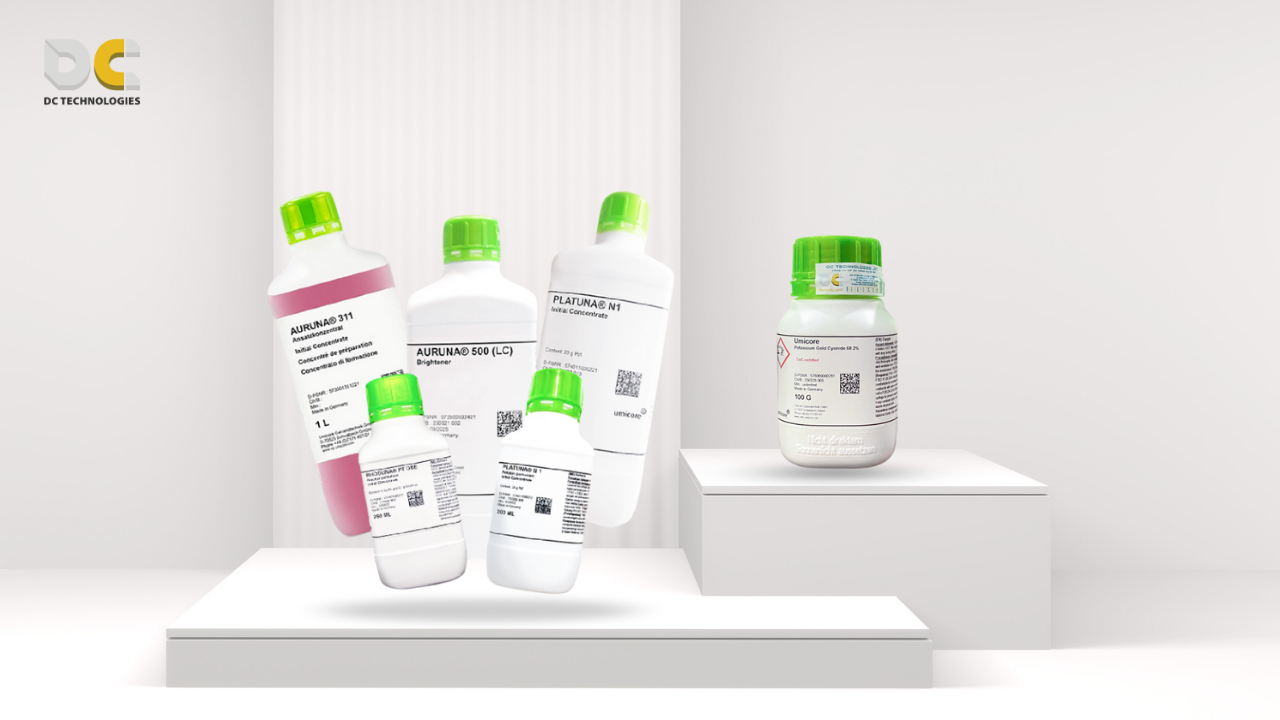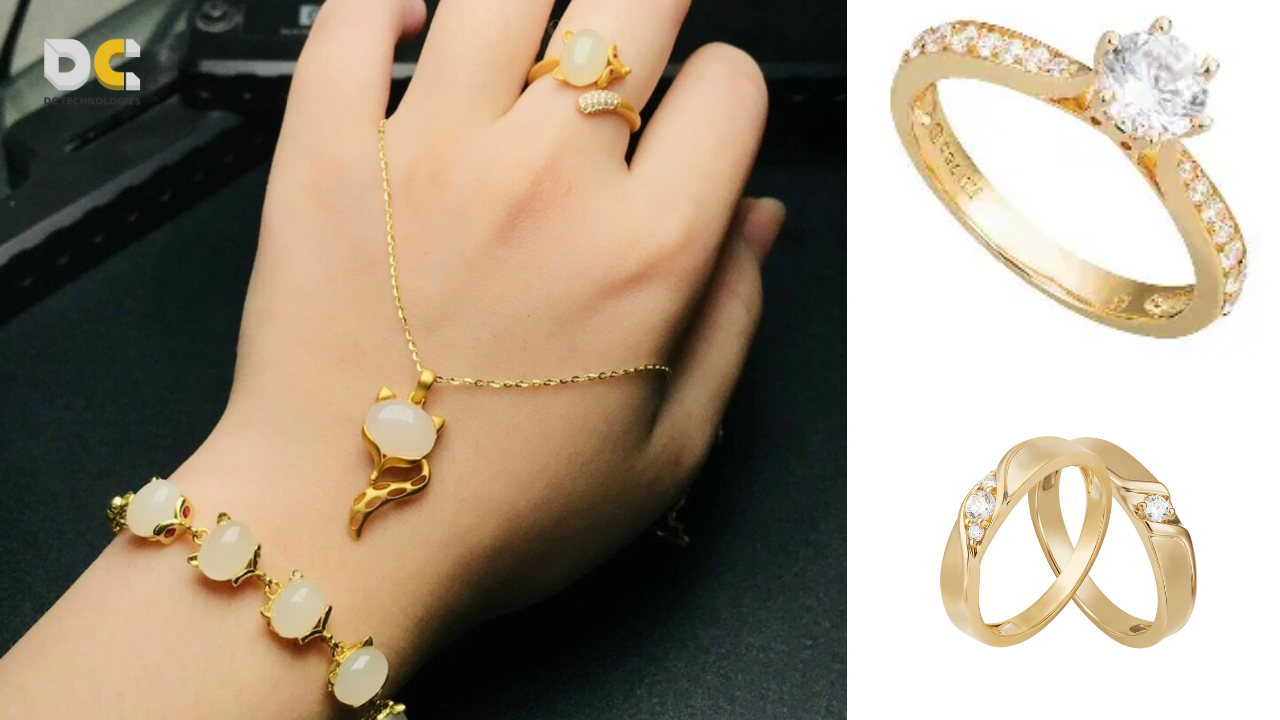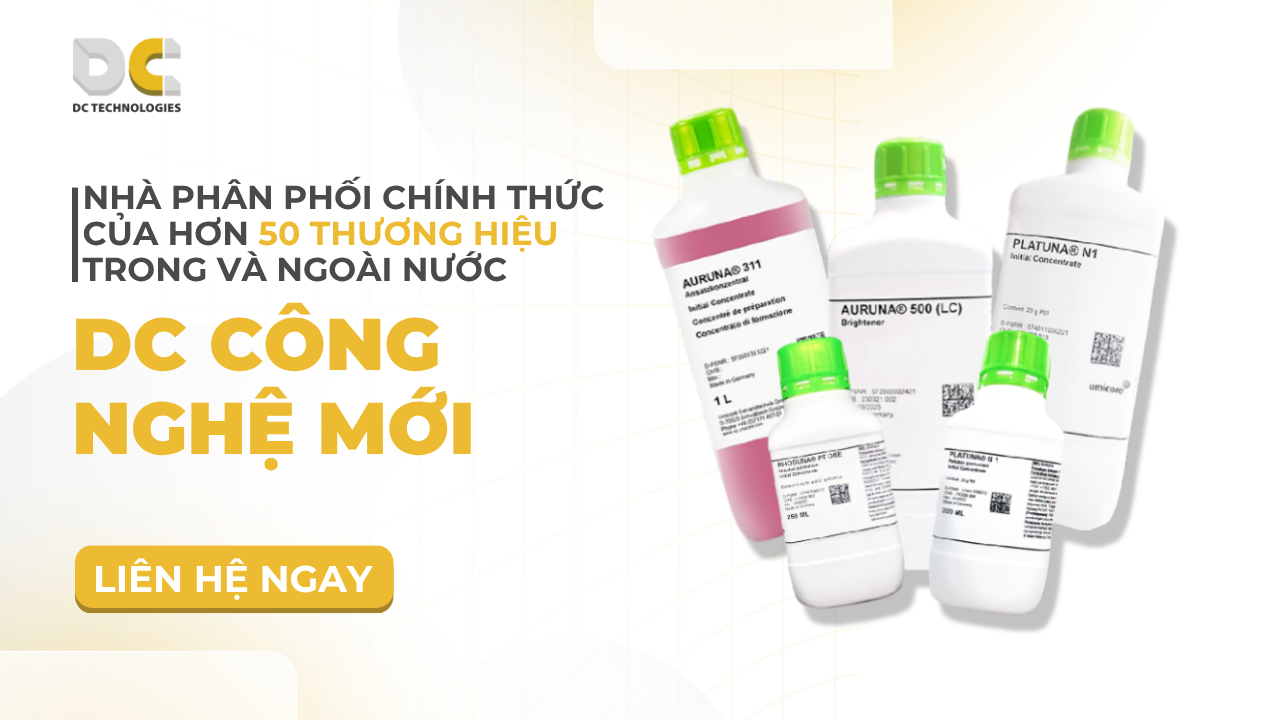Chia sẻ kinh nghiệm
What Is Gold Plating Chemical? Applications in the Industry
Gold plating is not merely a decorative technique - it is an intricate art that combines science, precision, and advanced technology. From delicate rings and necklaces to microelectronic components, a thin layer of gold can make a tremendous difference in terms of value, durability, and aesthetics.
At the heart of this process lies the gold plating chemical – the key factor determining the brightness, color durability, and adhesion quality of the plated layer.
So, what exactly is gold plating chemical, why is it so important, and where can you find a reputable supplier in Vietnam? This article will help you understand everything from the concept, usage process, and applications in the jewelry industry to how to select internationally standardized chemicals, ensuring every gold-plated product is not only beautiful but also durable and of the highest quality.
I. What Is Gold Plating Chemical?
Gold plating chemical is a specialized solution used to coat a thin layer of gold onto the surface of materials such as copper, silver, nickel, or alloys. This is a crucial stage that produces a gold-plated layer with high gloss, exceptional aesthetics, and outstanding resistance to oxidation.
In modern industry, gold plating chemicals are generally classified into two main categories: real gold plating chemicals (Gold Plating) and gold-colored plating chemicals (Gold-colored Plating).
The first type contains real gold ions (Au³⁺) in the solution, typically used for high-end products such as jewelry, watches, and electronic components.
The second type utilizes other metal compounds such as titanium, copper, or nickel to create a similar golden color but at a lower cost.
>> Read more: What Are Metal Plating Chemicals? Applications in the Jewelry Industry
>> Read more: International Standard Gold Plating Process Using Specialized Chemicals
II. How to Use Gold Plating Chemical

The use of gold plating chemicals requires precision and strict adherence to technical procedures.
First, the metal surface must be thoroughly cleaned using degreasing and descaling chemicals to remove dirt, oil, and oxides. This step is crucial because even the smallest contaminants can cause peeling or discoloration of the plated layer.
Next is surface activation, usually done with a mild acid solution to make the metal surface more reactive and ready for plating. The product is then immersed in a gold plating bath containing the chemical solution. Under the influence of electric current (in electrolytic plating) or chemical reactions (in electroless plating), gold ions are deposited onto the surface, forming a uniform, glossy coating.
Finally comes post-plating treatment, including rinsing with deionized water, drying, and polishing to enhance brightness and color durability. For high-end products, an additional protective layer such as an anti-oxidation coating or rhodium plating may be applied to improve scratch resistance.
III. Applications of Gold Plating Chemicals in the Jewelry Industry
1. Jewelry and Fashion Accessories
This is the most common application of gold plating chemicals. By using gold plating, jewelry made of copper, silver, or alloys can achieve a luxurious and refined appearance similar to solid gold.
Gold plating technology significantly reduces production costs, offering consumers stylish and elegant choices at affordable prices. Moreover, the gold layer enhances color durability, prevents oxidation, and keeps jewelry from tarnishing over time.

2. Handicrafts and Premium Gifts
In the field of handicrafts, gold plating chemicals are used to coat items such as photo frames, statues, decorative pieces, and souvenir gifts. The gold layer adds sophistication, shine, and luxury to the products.
Items such as medals, emblems, and gold-coated photo frames are commonly manufactured using this technique to ensure lasting beauty, durability, and aesthetic appeal.
>> Xem thêm: Leading Global Brand of Gold Plating Chemicals – Umicore
>> Xem thêm: Classification of Plating Chemicals: Gold, Silver, Rhodium, and Nickel

3. Electronics and High-Tech Industry
Beyond jewelry, gold plating chemicals play a critical role in the electronics industry. Gold’s excellent electrical conductivity and oxidation resistance make it ideal for coating components such as chips, connectors, circuit boards, and USB contacts.
Using high-quality gold plating chemicals ensures signal stability, precision, and extended device lifespan - all vital in manufacturing phones, computers, and other high-tech equipment.
IV. Advantages and Disdvantages of Gold Plating Chemicals
1. ADVANTAGES
Enhanced Aesthetics: The gold-plated layer adds brilliance, luxury, and attractiveness to products.
Oxidation and Corrosion Resistance: Gold is a noble metal with high chemical stability, ensuring product longevity.
Cost Efficiency: Compared to solid gold, gold plating provides similar visual appeal at a fraction of the cost.
Wide Application: Suitable for various materials such as copper, silver, nickel, stainless steel, and conductive plastics.
2. DISADVANTAGES
Durability Depends on Quality and Process: Poor-quality chemicals or improper processes can lead to peeling or uneven coloration.
High Technical Requirements: Operators must be well-trained, as minor deviations in temperature, solution concentration, or plating time can affect results.
Initial Investment Cost: To meet international standards, businesses must invest in equipment, quality chemicals, and strict process control systems.
>> Xem thêm: How to Choose High-Quality Plating Chemicals
>> Xem thêm: How to Preserve Precious Metals in Production and Storage
V. Trusted Suppliers of Gold Plating Chemicals in Vietnam

1. Key Criteria for Selecting a Supplier
To ensure product quality, businesses should choose suppliers that meet the following criteria:
Verified Origin: Chemicals with transparent certification (CO, CQ) and traceable sources.
Certified Quality: Products meeting international standards for safety and environmental protection.
Professional Technical Support: A team of experienced engineers providing ongoing technical consultation and assistance.
Reliable After-Sales Policy: Warranty, operation guidance, and troubleshooting support.
2. Recommended Supplier
In Vietnam, DC Technologies is trusted by numerous enterprises for providing premium gold plating chemicals. DC is the official distributor of Umicore (Germany) – a world-leading corporation in chemicals and advanced materials.
Umicore is globally recognized for its internationally certified, eco-friendly products widely used in jewelry, electronics, and precision engineering.
Beyond distribution, DC offers comprehensive technical consulting services, helping businesses optimize production processes and reduce costs.
DC Technologies’s Commitments:
Providing gold plating chemicals that meet international standards for long-lasting, high-quality plating results.
Supplying eco-friendly and user-safe chemicals.
Delivering dedicated technical support and guidance.
Offering professional after-sales service and long-term partnership with enterprises.
If you are looking for a reliable gold plating chemical supplier in Vietnam, DC is the trusted partner to help you enhance product quality and achieve sustainable growth in your industry.
VI. Conclusion
Gold plating chemicals play a crucial role in producing high-quality, aesthetically pleasing, and internationally compliant products. From jewelry and handicrafts to electronics, gold plating not only elevates product value but also reflects the technical excellence of a business.
To achieve a flawless gold-plated finish, selecting certified chemicals and a reputable supplier such as DC – the official partner of Umicore – is the key. Investing in high-quality plating chemicals today is an investment in long-term brand reputation and sustainable business success.
